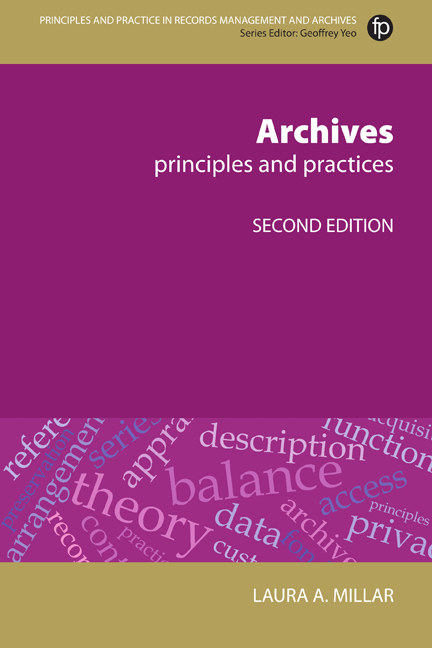Book contents
- Frontmatter
- Contents
- Figures and tables
- Foreword to the first edition
- Foreword to the second edition
- Acknowledgements
- Introduction to the second edition
- PART I ARCHIVAL PRINCIPLES
- 1 What are archives?
- 2 The nature of archives
- 3 Archival history and theory
- 4 The uses of archives
- 5 Types of archival institution
- 6 The principles of archival service
- 7 Balancing access and privacy
- PART II ARCHIVAL PRACTICES
- Conclusion
- To learn more
- Glossary of terms
- Index
- Miscellaneous Endmatter
1 - What are archives?
from PART I - ARCHIVAL PRINCIPLES
Published online by Cambridge University Press: 08 June 2018
- Frontmatter
- Contents
- Figures and tables
- Foreword to the first edition
- Foreword to the second edition
- Acknowledgements
- Introduction to the second edition
- PART I ARCHIVAL PRINCIPLES
- 1 What are archives?
- 2 The nature of archives
- 3 Archival history and theory
- 4 The uses of archives
- 5 Types of archival institution
- 6 The principles of archival service
- 7 Balancing access and privacy
- PART II ARCHIVAL PRACTICES
- Conclusion
- To learn more
- Glossary of terms
- Index
- Miscellaneous Endmatter
Summary
A wise man proportions his belief to the evidence.
David Hume (1711–76) An Enquiry Concerning Human Understanding, 1748The word ‘archives’ conjures up different images. Some people picture dusty, dry storage rooms where stuffy, brown-bow-tie curators enveloped in ancient cardigans look askance at anyone who speaks above a whisper. Others imagine websites where listeners can download podcasts of radio programmes aired just hours before. Some people think of old parchments, scrolls and leather-bound volumes of medieval treatises; others imagine electronic back-up copies of a corporate report or membership database.
Two centuries ago, the majority of archival materials were twodimensional, manually created items such as papyrus scrolls, parchment codices, bound ledgers, or black and white photographs. Today, the holdings of archival institutions may include e-mail messages, relational databases, YouTube videos and interactive web pages. Digital technologies have transformed our understanding of the nature of information and commun - ications; what were considered archives a century ago are only the smallest subset of what might be defined as archives today.
Computers and the internet have also bred a growth industry in the dissemination of digital archival information. Governments, corporations, publishers, music producers, writers, performers and artists have all discovered the value of sharing information, including historical records, electronically. Newspapers reprint archived articles in print and online editions. Radio stations post copies of concerts and interviews on their websites. Music producers repackage old recordings, billing them as treasures from the vault. Entire television channels are devoted to broadcasting ‘classic’ TV shows and movies, and historical documentaries and ‘find your ancestor’ genealogical shows are among the most popular subset of reality TV on air today. Even local churches record their Sunday sermons and post them on their Facebook pages to serve home-bound parishioners.
As more and more people are exposed to digital information, both old and new, the concept of archives has become more ambiguous. The blanket depiction of archives as brittle old documents used only by scholars has been replaced by another stereotype: that archives comprise any piece of information older than yesterday that might be worth referring to again tomorrow. For those who decide to create an online repository of their favourite recipes or music or newspaper articles and call it their ‘archive’, the subtleties of language may be of little consequence.
Information
- Type
- Chapter
- Information
- ArchivesPrinciples and Practices, pp. 3 - 22Publisher: FacetPrint publication year: 2017
